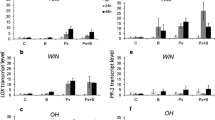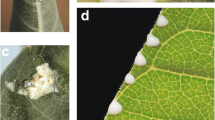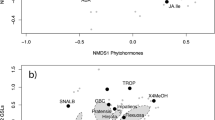Abstract
Despite the recognition that phytohormonal signaling mediates induced responses to herbivory, we still have little understanding of how such signaling varies among closely related species and may generate herbivore-specific induced responses. We studied closely related milkweeds (Asclepias) to link: 1) plant damage by two specialist chewing herbivores (milkweed leaf beetles Labidomera clivicolis and monarch caterpillars Danaus plexippus); 2) production of the phytohormones jasmonic acid (JA), salicylic acid (SA), and abscisic acid (ABA); 3) induction of defensive cardenolides and latex; and 4) impacts on Danaus caterpillars. We first show that A. syriaca exhibits induced resistance following monarch herbivory (i.e., reduced monarch growth on previously damaged plants), while the defensively dissimilar A. tuberosa does not. We next worked with a broader group of five Asclepias, including these two species, that are highly divergent in defensive traits yet from the same clade. Three of the five species showed herbivore-induced changes in cardenolides, while induced latex was found in four species. Among the phytohormones, JA and ABA showed specific responses (although they generally increased) to insect species and among the plant species. In contrast, SA responses were consistent among plant and herbivore species, showing a decline following herbivore attack. Jasmonic acid showed a positive quantitative relationship only with latex, and this was strongest in plants damaged by D. plexippus. Although phytohormones showed qualitative tradeoffs (i.e., treatments that enhanced JA reduced SA), the few significant individual plant-level correlations among hormones were positive, and these were strongest between JA and ABA in monarch damaged plants. We conclude that: 1) latex exudation is positively associated with endogenous JA levels, even among low-latex species; 2) correlations among milkweed hormones are generally positive, although herbivore damage induces a divergence (tradeoff) between JA and SA; 3) induction of cardenolides and latex are not necessarily physiologically linked; and 4) even very closely related species show highly divergent induction, with some species showing strong defenses, hormonally-mediated induction, and impacts on herbivores, while other milkweed species apparently use alternative strategies to cope with insect attack.








Similar content being viewed by others
References
Agrawal AA (2001) Phenotypic plasticity in the interactions and evolution of species. Science 294:321–326
Agrawal AA (2005) Natural selection on common milkweed (Asclepias syriaca) by a community of specialized insect herbivores. Evol Ecol Res 7:651–667
Agrawal AA (2011) Current trends in the evolutionary ecology of plant defence. Funct Ecol 25:420–432
Agrawal AA, Fishbein M (2006) Plant defense syndromes. Ecology 87:S132–S149
Agrawal AA, Fishbein M (2008) Phylogenetic escalation and decline of plant defense strategies. Proc Natl Acad Sci U S A 105:10057–10060
Agrawal AA, Konno K (2009) Latex: a model for understanding mechanisms, ecology, and evolution of plant defense against herbivory. Annu Rev Ecol Evol Syst 40:311–331
Agrawal AA, Fishbein M, Halitschke R, Hastings AP, Rabosky DL, Rasmann S (2009) Evidence for adaptive radiation from a phylogenetic study of plant defenses. Proc Natl Acad Sci U S A 106:18067–18072
Agrawal AA, Kearney EE, Hastings AP, Ramsey TE (2012a) Attenuation of the jasmonate burst, plant defensive traits, and resistance to specialist monarch caterpillars on shaded common milkweed (Asclepias syriaca). J Chem Ecol 38:893–901
Agrawal AA, Petschenka G, Bingham RA, Weber MG, Rasmann S (2012b) Toxic cardenolides: chemical ecology and coevolution of specialized plant-herbivore interactions. New Phytol 194:28–45
Agrawal AA, Ali JG, Rasmann S, Fishbein M (2014) Macroevolutionary trends in the defense of milkweeds against monarchs: latex, cardenolides, and tolerance of herbivory. In: Oberhauser K, Altizer S, Nail K (eds) Monarchs in a changing world: biology and conservation of an iconic insect. Cornell University Press (in press)
Ali JG, Agrawal AA (2012) Specialist versus generalist insect herbivores and plant defense. Trends Plant Sci 17:293–302
Ali JG, Agrawal AA (2014) Asymmetry of plant-mediated interactions between insects from two feeding guilds. Funct Ecol. doi:10.1111/1365-2435.12271
Avanci NC, Luche DD, Goldman GH, Goldman MHS (2010) Jasmonates are phytohormones with multiple functions, including plant defense and reproduction. Genet Mol Res 9:484–505
Bingham RA, Agrawal AA (2010) Ecological genetics of herbivore-specific induced defenses in common milkweed. J Ecol 98:1014–1022
Broekaert W, Lee HI, Kush A, Chua NH, Raikhel N (1990) Wound-induced accumulation of messenger-RNA containing a hevein sequence in laticifers of rubber tree (Hevea brasiliensis). Proc Natl Acad Sci U S A 87:7633–7637
Cipollini D (2004) Stretching the limits of plasticity: can a plant defend against both competitors and herbivores? Ecology 85:28–37
De Moraes CM, Lewis WJ, Pare PW, Alborn HT, Tumlinson JH (1998) Herbivore-infested plants selectively attract parasitoids. Nature 393:570–573
Erb M, Flors V, Karlen D, de Lange E, Planchamp C, D’Alessandro M, Turlings TCJ, Ton J (2009) Signal signature of aboveground-induced resistance upon belowground herbivory in maize. Plant J 59:292–302
Erb M, Meldau S, Howe GA (2012) Role of phytohormones in insect-specific plant reactions. Trends Plant Sci 17:250–259
Fishbein M, Chuba D, Ellison C, Mason-Gamer RJ, Lynch SP (2011) Phylogenetic relationships of asclepias (Apocynaceae) inferred from non-coding chloroplast DNA sequences. Syst Bot 36:1008–1023
Halitschke R, Baldwin IT (2003) Antisense LOX expression increases herbivore performance by decreasing defense responses and inhibiting growth-related transcriptional reorganization in Nicotiana attenuata. Plant J 36:794–807
Haribal M, Renwick JAA (1998) Identification and distribution of oviposition stimulants for monarch butterflies in hosts and nonhosts. J Chem Ecol 24:891–904
Heil M, Greiner S, Meimberg H, Kruger R, Noyer JL, Heubl G, Linsenmair KE, Boland W (2004) Evolutionary change from induced to constitutive expression of an indirect plant resistance. Nature 430:205–208
Koornneef A, Leon-Reyes A, Ritsema T, Verhage A, Den Otter FC, Van Loon LC, Pieterse CMJ (2008) Kinetics of salicylate-mediated suppression of jasmonate signaling reveal a role for redox modulation. Plant Physiol 147:1358–1368
Lackman P, Gonzalez-Guzman M, Tilleman S, Carqueijeiro I, Perez AC, Moses T, Seo M, Kanno Y, Hakkinen ST, Van Montagu MCE and others (2011) Jasmonate signaling involves the abscisic acid receptor PYL4 to regulate metabolic reprogramming in Arabidopsis and tobacco. Proc Natl Acad Sci U S A 108:5891–5896
Leon-Reyes A, Spoel SH, De Lange ES, Abe H, Kobayashi M, Tsuda S, Millenaar FF, Welschen RAM, Ritsema T, Pieterse CMJ (2009) Ethylene modulates the role of nonexpressor of pathogenesis-related genes1 in cross talk between salicylate and jasmonate signaling. Plant Physiol 149:1797–1809
Leon-Reyes A, Du YJ, Koornneef A, Proietti S, Korbes AP, Memelink J, Pieterse CMJ, Ritsema T (2010) Ethylene signaling renders the jasmonate response of Arabidopsis insensitive to future suppression by salicylic acid. Mol Plant Microbe Interact 23:187–197
Malcolm SB, Zalucki MP (1996) Milkweed latex and cardenolide induction may resolve the lethal plant defence paradox. Entomol Exp Appl 80:193–196
Malcolm SB, Cockrell BJ, Brower LP (1989) Cardenolide fingerprint of monarch butterflies reared on common milkweed, Asclepias syriaca L. J Chem Ecol 15:819–853
Mooney KA, Jones P, Agrawal AA (2008) Coexisting congeners: demography, competition, and interactions with cardenolides for two milkweed-feeding aphids. Oikos 117:450–458
Moreno JE, Tao Y, Chory J, Ballare CL (2009) Ecological modulation of plant defense via phytochrome control of jasmonate sensitivity. Proc Natl Acad Sci U S A 106:4935–4940
Mur LAJ, Kenton P, Atzorn R, Miersch O, Wasternack C (2006) The outcomes of concentration-specific interactions between salicylate and jasmonate signaling include synergy, antagonism, and oxidative stress leading to cell death. Plant Physiol 140:249–262
Musser RO, Cipollini DF, Hum-Musser SM, Williams SA, Brown JK, Felton GW (2005) Evidence that the caterpillar salivary enzyme glucose oxidase provides herbivore offense in Solanaceous plants. Arch Insect Biochem Physiol 58:128–137
Rasmann S, Agrawal AA (2009) Plant defense against herbivory: progress in identifying synergism, redundancy, and antagonism between resistance traits. Cur Opin Plant Biol 12(4):473–478
Rasmann S, Agrawal AA (2011) Latitudinal patterns in plant defense: evolution of cardenolides, their toxicity and induction following herbivory. Ecol Lett 14:476–483
Rasmann S, Johnson MD, Agrawal AA (2009) Induced responses to herbivory and jasmonate in three milkweed species. J Chem Ecol 35:1326–1334
Reymond P, Farmer EE (1998) Jasmonate and salicylate as global signals for defense gene expression. Cur Opin Plant Biol 1:404–411
Reymond P, Weber H, Damond M, Farmer EE (2000) Differential gene expression in response to mechanical wounding and insect feeding in Arabidopsis. Plant Cell 12:707–719
Schmelz EA, Engelberth J, Alborn HT, O’Donnell P, Sammons M, Toshima H, Tumlinson JH (2003) Simultaneous analysis of phytohormones, phytotoxins, and volatile organic compounds in plants. Proc Natl Acad Sci U S A 100:10552–10557
Schuman MC, Heinzel N, Gaquerel E, Svatos A, Baldwin IT (2009) Polymorphism in jasmonate signaling partially accounts for the variety of volatiles produced by Nicotiana attenuata plants in a native population. New Phytol 183:1134–1148
Thaler JS, Bostock RM (2004) Interactions between abscisic-acid-mediated responses and plant resistance to pathogens and insects. Ecology 85:48–58
Thaler JS, Karban R (1997) A phylogenetic reconstruction of constitutive and induced resistance in Gossypium. Am Nat 149:1139–1146
Thaler JS, Farag MA, Pare PW, Dicke M (2002) Jasmonate-deficient plants have reduced direct and indirect defences against herbivores. Ecol Lett 5:764–774
Thaler JS, Agrawal AA, Halitschke R (2010) Salicylate-mediated interactions between pathogens and herbivores. Ecology 91:1075–1082
Thaler JS, Humphrey PT, Whiteman NK (2012) Evolution of jasmonate and salicylate signal crosstalk. Trends Plant Sci 17:260–270
Traw MB, Bergelson J (2003) Interactive effects of jasmonic acid, salicylic acid, and gibberellin on induction of trichomes in Arabidopsis. Plant Physiol 133:1367–1375
Van Zandt PA, Agrawal AA (2004a) Community-wide impacts of herbivore-induced plant responses in milkweed (Asclepias syriaca). Ecology 85:2616–2629
Van Zandt PA, Agrawal AA (2004b) Specificity of induced plant responses to specialist herbivores of the common milkweed, Asclepias syriaca. Oikos 104:401–409
Vannette RL, Hunter MD (2011) Genetic variation in expression of defense phenotype may mediate evolutionary adaptation of Asclepias syriaca to elevated CO2. Glob Chang Biol 17:1277–1288
Viswanathan DV, Narwani AJT, Thaler JS (2005) Specificity in induced plant responses shapes patterns of herbivore occurrence on Solanum dulcamara. Ecology 86:886–896
von Dahl CC, Baldwin IT (2007) Deciphering the role of ethylene in plant-herbivore interactions. J Plant Growth Regul 26:201–209
Warashina T, Noro T (2009) 8,14-Secopregnane glycosides from the aerial parts of Asclepias tuberosa. Phytochemistry 70:1294–1304
Woodson RE (1954) The North American species of Asclepias L. Ann Miss Bot Garden 41:1–211
Zalucki MP, Malcolm SB (1999) Plant latex and first-instar monarch larval growth and survival on three North American milkweed species. J Chem Ecol 25:1827–1842
Zalucki MP, Brower LP, Alonso A (2001) Detrimental effects of latex and cardiac glycosides on survival and growth of first-instar monarch butterfly larvae Danaus plexippus feeding on the sandhill milkweed Asclepias humistrata. Ecological Entomol 26:212–224
Zehnder CB, Hunter MD (2007) Interspecific variation within the genus Asclepias in response to herbivory by a phloem-feeding insect herbivore. J Chem Ecol 33:2044–2053
Zehnder CB, Hunter MD (2008) Effects of nitrogen deposition on the interaction between an aphid and its host plant. Ecological Entomol 33:24–30
Acknowledgements
This study was improved by discussions and input from Jared Ali, Rayko Halitschke, Monica Kersch-Becker, Georg Petschenka, Jennifer Thaler, Tobias Züst, and the Phytophagy Lab at Cornell University. We thank Mark Fishbein for help with the phylogeny of Asclepias and Marc Johnson and Peter Van Zandt for collecting A. obovata seeds. We thank T. Ramsey for help conducting the experiments, E. Kearney and C. Creneti for sample preparation, and J. Kerr for help with cardenolide analysis. Our research and lab (www.herbivory.com/) is currently supported by NSF-DEB 1118783 and the Templeton Foundation.
Author information
Authors and Affiliations
Corresponding author
Rights and permissions
About this article
Cite this article
Agrawal, A.A., Hastings, A.P., Patrick, E.T. et al. Specificity of Herbivore-Induced Hormonal Signaling and Defensive Traits in Five Closely Related Milkweeds (Asclepias spp.). J Chem Ecol 40, 717–729 (2014). https://doi.org/10.1007/s10886-014-0449-6
Received:
Revised:
Accepted:
Published:
Issue Date:
DOI: https://doi.org/10.1007/s10886-014-0449-6




